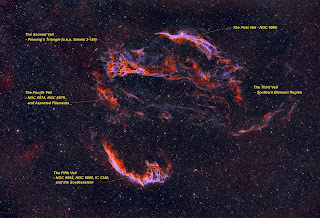The Veil Nebula is so large that it consists of several different NGC numbers describing different parts but I like the way Banich separated it into five parts.
1 - The First Veil - NGC 6960 located on the western side is also known as the Witch’s Broom.
2 - The Second Veil - Fleming’s Triangle (formerly Pickering’s Triangle) also known as Simeis 3-188 was discovered by Williamina Fleming in 1904 at the Harvard College Observatory but credit was given to her director E. C. Pickering until recently.
3 - The Third Veil - Southern Blowout Region is very faint and located at the bottom edge of Fleming’s Triangle.
4 - The Fourth Veil - NGC 6974, NGC 6979, and Assorted Filaments are located just east of Fleming’s Triangle and are also quite dim.
5 - The Fifth Veil - NGC 6992, NGC 6995, IC 1340, and the Southeastern Knot are all located on the eastern side. The portion is very bright and to me, resembles a claw.
Note: My image is rotated 90 degrees so west is top, south is right, east is bottom, and north is left (most images of the Cygnus Loop are rotated like this).
I spent many nights trying to capture enough data between the clouds in order to bring out the Ha gas and extra dust but did not capture what I had hoped in that regard, however, I am happy with what I did get main nebula wise. I captured 436 three minute subframes after and initial inspection but did another inspection with the PI Subframe Selector and trashed another 137 frames - I have to be very careful as the sky conditions here in southern CT are not that stable. There are hints of the faint Ha in my image specially on the left side of my image but I believe longer exposure subframes such as 10 minutes are needed to bring that out (at least that is what Jeffrey Horne did with his recent image of this).
4 - The Fourth Veil - NGC 6974, NGC 6979, and Assorted Filaments are located just east of Fleming’s Triangle and are also quite dim.
5 - The Fifth Veil - NGC 6992, NGC 6995, IC 1340, and the Southeastern Knot are all located on the eastern side. The portion is very bright and to me, resembles a claw.
Note: My image is rotated 90 degrees so west is top, south is right, east is bottom, and north is left (most images of the Cygnus Loop are rotated like this).
I spent many nights trying to capture enough data between the clouds in order to bring out the Ha gas and extra dust but did not capture what I had hoped in that regard, however, I am happy with what I did get main nebula wise. I captured 436 three minute subframes after and initial inspection but did another inspection with the PI Subframe Selector and trashed another 137 frames - I have to be very careful as the sky conditions here in southern CT are not that stable. There are hints of the faint Ha in my image specially on the left side of my image but I believe longer exposure subframes such as 10 minutes are needed to bring that out (at least that is what Jeffrey Horne did with his recent image of this).
Veil Nebula (a.k.a. Cygnus Loop)
Dates: 9-10, 9-11, 9-13, 9-18, 9-19, 9-20, 9-24, 9-26, 9-27, 9-30, 10-1
Camera: ZWO ASI294MC-Pro
Telescope: Canon EF 200mm f/2.8L II USM Lens
Barlow: None
Focal Length: 200mm
f/4.0
Focal Reducer: none
Mount: Orion Atlas Pro
Filter Adaptor: ZWO EOS Filter Drawer
Filter: IDAS NBZ (2-inch)
Focuser: None
Autoguiding: ASI120 Mini attached to a ZWO Mini guidescope - None
Exposure: L 299 x 180
Gain: 139
Offset 0
Temp: 0 C
Processing: NINA, PixInsight, Photoshop, Gradient Exterminator, Topaz DeNoiseAI.
https://www.instagram.com/astroquest1/
http://astroquest1.blogspot.com/
https://www.astrobin.com/users/kurtzepp/collections/
http://youtube.com/c/AstroQuest1
Camera: ZWO ASI294MC-Pro
Telescope: Canon EF 200mm f/2.8L II USM Lens
Barlow: None
Focal Length: 200mm
f/4.0
Focal Reducer: none
Mount: Orion Atlas Pro
Filter Adaptor: ZWO EOS Filter Drawer
Filter: IDAS NBZ (2-inch)
Focuser: None
Autoguiding: ASI120 Mini attached to a ZWO Mini guidescope - None
Exposure: L 299 x 180
Gain: 139
Offset 0
Temp: 0 C
Processing: NINA, PixInsight, Photoshop, Gradient Exterminator, Topaz DeNoiseAI.
https://www.instagram.com/astroquest1/
http://astroquest1.blogspot.com/
https://www.astrobin.com/users/kurtzepp/collections/
http://youtube.com/c/AstroQuest1




